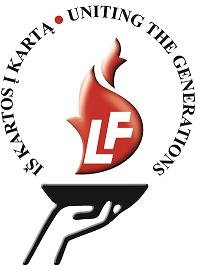Eastern Europe
Note: The part of Europe ruled by communists before 1990 is described here. It includes parts of Asia in the former USSR.
In the 15th-16th centuries, the Grand Duchy of Lithuania was the Europe's largest country. Numerous castles, manors, and their ruins, once established by Lithuanian rulers and noble families, exist in Belarus and Ukraine. The subsequent creation of Polish-Lithuanian Commonwealth (16th-18th centuries) means that many places in Poland and Latvia are related to Lithuania as well. The ethnic boundaries of Lithuanian nation went beyond today's state borders so there are culturally important Lithuanian places in modern-day Kaliningrad Oblast of Russia.

Grand Duchy of Lithuania castle in Kamianets Podilskyi, modern-day Ukraine, used to defend the Grand Duchy from Ottomans, Tatars and Cossacks since it was conquered by Vytautas the Great in 1393 and expanded by his succesors. Elected to be one of the Seven Wonders of Ukraine. ©Augustinas Žemaitis.
The 20th century brought much sadder events. The great Soviet exiles were among the most tragic moments in the Lithuanian history. This was a Soviet policy of 1940-1953 whereby hundreds of thousands of Lithuanians (entire families with children and babies) were stripped of their belongings, stuffed into cattle carriages and deported to various places in Siberia, Kazakhstan and Tajikistan. Many perished - for instance out of those deported in 1941 more than 50% died due to harsh conditions (down to -70 C winter cold) and forced labor in the Soviet concentration camps.
They left only humble crosses now crumbling in permafrost. Since the late 1990s, there have been Lithuanian youth expeditions "Mission: Siberia" to clean these graveyards. Russia is still suspicious of any such activity which reminds the Soviet genocide. Its government impeded the Lithuanian-funded construction of memorials for victims in places like Yakutsk.
The families of the upper and middle class, teachers, artists who refused to glorify Stalin, lawyers, architects, soldiers and anybody deemed "disloyal to the Soviet system" were exiled. The Genocide of Lithuanians was not unique - many other Soviet minorities suffered even worse fate. Many other ethnicities saw their entire population deported (regardless of age, occupation or political views). Such plan was devised for Lithuanians too ("There will be Lithuania - But without the Lithuanians" are the infamous words of Commissioner Mikhail Suslov) but not completed.

Lithuanian deportee graveyard in Irkutsk Oblast, Russia. Tens of thousands of such crumbling crosses exist all over the desolate parts of former USSR and even more graves are unmarked. Photo by expedition Mission: Siberia, aimed at cleaning these graveyards. Epitaph on the left reads: SADDENED WE LEAVE YOU IN SIBERIAN GRAVES, NOT KNOWING WHERE THE WINDS OF FATE WILL BLOW US.
After the death of Stalin, the repressions eased and Lithuanian deportees were allowed to return to the homeland or at least its vicinity. However, the returnees were not given back any property and were always held in suspicion, excluded from decent jobs and education. Therefore some chose not to return and still inhabit the Siberian villages. Such villages are hard to reach and foreigners are still banned from many places there.
While the Soviet expulsions forced more Lithuanians eastwards than anything else there are other Lithuanian marks in the Eastern Europe.
While the Soviet Union effectively banned emigration there was a massive internal migration. Some Lithuanians were given jobs outside their titular country. Today there are Lithuanian communities in the majority of the post-Soviet countries. Soviets established a pan-Union network of Russian language institutions (schools, university programs, theaters, media) at the same time banning minority language institutions, fostering russification. This way the minorities, including Lithuanians outside Lithuanian SSR, had to use Russian institutions and a large share of them adopted Russian language and culture. After 1990 some Lithuanian cultural institutions were allowed to open. They are concentrated to main cities such as Moscow, Kiev or Saint Petersburg.






Leave a comment